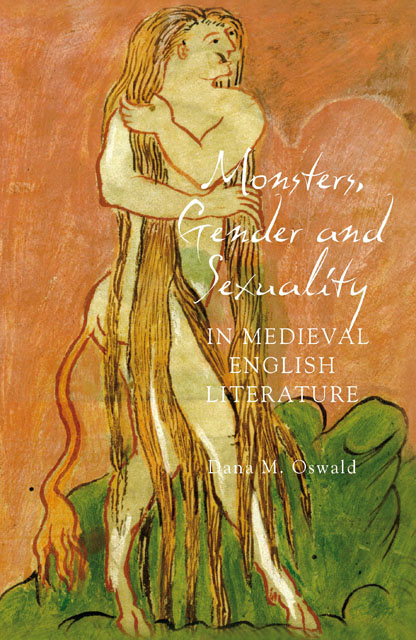Book contents
- Frontmatter
- Contents
- Dedication
- Acknowledgements
- List of Figures
- Introduction: Sex and the Single Monster
- 1 The Indecent Bodies of the Wonders of the East
- 2 Dismemberment as Erasure: the Monstrous Body in Beowulf
- 3 Circulation and Transformation: The Monstrous Feminine in Mandeville’s Travels
- 4 Paternity and Monstrosity in the Alliterative Morte Arthure and Sir Gowther
- Conclusion: Transformation and the Trace of the Monster
- Bibliography
- Index
Introduction: Sex and the Single Monster
Published online by Cambridge University Press: 01 March 2023
- Frontmatter
- Contents
- Dedication
- Acknowledgements
- List of Figures
- Introduction: Sex and the Single Monster
- 1 The Indecent Bodies of the Wonders of the East
- 2 Dismemberment as Erasure: the Monstrous Body in Beowulf
- 3 Circulation and Transformation: The Monstrous Feminine in Mandeville’s Travels
- 4 Paternity and Monstrosity in the Alliterative Morte Arthure and Sir Gowther
- Conclusion: Transformation and the Trace of the Monster
- Bibliography
- Index
Summary
The mind needs monsters. Monsters embody all that is dangerous and horrible in the human imagination. – David Gilmore (1)
For all of the famed restrictions of Christian doctrine and medieval modes of social conduct, the Middle Ages was, perhaps paradoxically, a period that appears to have accommodated, in ways our liberal society does not or seems not to, what we might broadly call the rude, bawdy or obscene. But that does not mean that, at different times and in different ways, it was not contentious nor that it was devoid of the power to shock or offend, as well as to titillate and excite. – Nicola McDonald (2)
JOHANNES HARTLIEB's 1461 portrait of Alexander the Great shows us a surprising version of the Greek leader (as reprinted in Petzoldt and Neubauer 41). This Alexander wears an elaborate three-peaked crown and a well-cut tunic, neither unusual nor inappropriate attire. His nose is decidedly Roman and his eyebrows pinch together in consternation over light-colored eyes that look intelligent. Despite all the signs of royalty and refinement, this Alexander bears two signs of barbarity: slender tusks protruding from his cheeks and an unkempt beard and hair. His clothes tell us of his wealth and political significance, but his crude animal attributes interrupt and contradict this story. Hartlieb portrays Alexander as a man overtaken by the mysterious East he hoped to conquer. Just as the lands that he conquered were known as barbarous to medieval readers and viewers, so too does Alexander's physical form in this image reflect the perceived qualities of these lands. Contact with the savage lands of the East has changed a leader of civilization into the monster as represented by Hartlieb. Though dressed in the proper attire and still obviously human in his facial features, this Alexander cannot hide his corruption. It peeks through in tousled hair, an untidy beard, and, most strikingly, those intractable tusks.
This fifteenth century German painting offers one perspective of the monstrous human body in medieval culture. The image suggests that congress with the dangerous lands of the East visibly contaminates the human body of Alexander – and indeed, in much early medieval literature, the monstrous exists only in distant places like the marvel-filled East.
- Type
- Chapter
- Information
- Publisher: Boydell & BrewerPrint publication year: 2010



